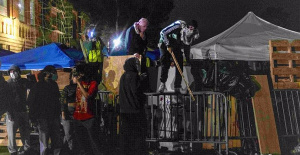Almost all the autonomous communities and cities have published the calls for aid for the residential rehabilitation program
MADRID, 26 Sep. (EUROPA PRESS) -
The Minister of Transport, Mobility and Urban Agenda, Raquel Sánchez, highlighted this Monday that 80% of households can now request European subsidies for residential rehabilitation, within the framework of the investments provided for in the Recovery, Transformation and Resilience Plan (PRTR).
And it is that almost all the communities have already published the calls for aid from the rehabilitation program for economic and social recovery in residential environments, endowed with 3,420 million euros, of which 1,151 have already been mobilized and 1,389 million are in process.
This was expressed by the minister at the Residential Rehabilitation Forum held this Monday at the Ministry headquarters and which was attended by representatives of the construction, real estate, architecture, and financial entities sectors, among others. .
In her speech, Raquel Sánchez defended the opportunity that the Recovery Plan and European funds represent in the field of residential rehabilitation, since they allow energy efficiency to be promoted and homes, residential buildings and neighborhoods to be improved. In this context, she has advocated joining efforts, pointing out that "investing in rehabilitation is also investing in economic and social development".
In her speech, the minister reviewed the situation of the building stock in Spain, which has approximately 25.7 million homes, of which nearly 19 million are primary residences. Of them, more than half are prior to 1980, so "they are very improvable" in terms of energy efficiency, and more than a million are in poor condition, deficient or dilapidated.
Likewise, he pointed out that, in rural areas, 30% of the building stock is prior to 1960, and secondary and empty dwellings account for 44%, 15 points more than the national average. Regarding the latter, more than 24% are in poor or dilapidated condition; and, in absolute values, more than 410,000 empty homes are practically uninhabitable.
As he explained, the refurbishment rate in Spain does not reach 0.1% per year of all dwellings, compared to France or Norway, where the percentage of dwellings refurbished per year is 2%; in Germany it is around 1.5%; and in Italy it stands at 0.77%, which is why, with the funds, the aim is to contribute to promoting this type of investment.
Thus, he stressed that the objective is to approach 300,000 actions per year, which is the goal set for 2030 in the Integrated National Plan for the Economy and Climate. In short, it is about multiplying by ten the annual residential renovations throughout this decade.
To achieve this, as has been stated, it is necessary to rehabilitate 1.2 million homes by 2030 and, in parallel, undertake a similar process annually with 300,000 square meters (m2) of buildings in the tertiary sector, both public and private.
In this regard, he added that meeting this objective will mean a reduction in annual primary energy consumption of around 3,000 gigawatt hours per year, which is equivalent to 23% of the savings established by the Energy and Climate Plan for the entire residential sector. .

 Exploring Cardano: Inner Workings and Advantages of this Cryptocurrency
Exploring Cardano: Inner Workings and Advantages of this Cryptocurrency Seville.- Economy.- Innova.- STSA inaugurates its new painting and sealing hangar in San Pablo, for 18 million
Seville.- Economy.- Innova.- STSA inaugurates its new painting and sealing hangar in San Pablo, for 18 million Innova.- More than 300 volunteers join the Andalucía Compromiso Digital network in one month to facilitate access to ICT
Innova.- More than 300 volunteers join the Andalucía Compromiso Digital network in one month to facilitate access to ICT Innova.-AMP.- Ayesa acquires 51% of Sadiel, which will create new technological engineering products and expand markets
Innova.-AMP.- Ayesa acquires 51% of Sadiel, which will create new technological engineering products and expand markets The Kings celebrate their 20th wedding anniversary with several family photos in the gardens of the Royal Palace
The Kings celebrate their 20th wedding anniversary with several family photos in the gardens of the Royal Palace Three Spanish tourists die and another is injured in a shooting in Afghanistan
Three Spanish tourists die and another is injured in a shooting in Afghanistan RELEASE: Moldova Innovation Technology Park presents a complete IT investment guide
RELEASE: Moldova Innovation Technology Park presents a complete IT investment guide RELEASE: Blackview HERO 10 launches globally with dual screens, 108 MP camera and Android Dynamic Island
RELEASE: Blackview HERO 10 launches globally with dual screens, 108 MP camera and Android Dynamic Island How Blockchain in being used to shape the future
How Blockchain in being used to shape the future Not just BTC and ETH: Here Are Some More Interesting Coins Worth Focusing on
Not just BTC and ETH: Here Are Some More Interesting Coins Worth Focusing on The UA participates in the proposed Ramses mission to study the close passage of an asteroid to Earth
The UA participates in the proposed Ramses mission to study the close passage of an asteroid to Earth They develop a tool to end discrimination biases in AI
They develop a tool to end discrimination biases in AI A research group from the UA works on the development of healthy foods through AI
A research group from the UA works on the development of healthy foods through AI The Valencian researcher José Rafael Penadés, named 'fellow' of the British Royal Society
The Valencian researcher José Rafael Penadés, named 'fellow' of the British Royal Society A million people demonstrate in France against Macron's pension reform
A million people demonstrate in France against Macron's pension reform Russia launches several missiles against "critical infrastructure" in the city of Zaporizhia
Russia launches several missiles against "critical infrastructure" in the city of Zaporizhia A "procession" remembers the dead of the Calabria shipwreck as bodies continue to wash up on the shore
A "procession" remembers the dead of the Calabria shipwreck as bodies continue to wash up on the shore Prison sentences handed down for three prominent Hong Kong pro-democracy activists
Prison sentences handed down for three prominent Hong Kong pro-democracy activists ETH continues to leave trading platforms, Ethereum balance on exchanges lowest in 3 years
ETH continues to leave trading platforms, Ethereum balance on exchanges lowest in 3 years Investors invest $450 million in Consensys, Ethereum incubator now valued at $7 billion
Investors invest $450 million in Consensys, Ethereum incubator now valued at $7 billion Alchemy Integrates Ethereum L2 Product Starknet to Enhance Web3 Scalability at a Price 100x Lower Than L1 Fees
Alchemy Integrates Ethereum L2 Product Starknet to Enhance Web3 Scalability at a Price 100x Lower Than L1 Fees Mining Report: Bitcoin's Electricity Consumption Declines by 25% in Q1 2022
Mining Report: Bitcoin's Electricity Consumption Declines by 25% in Q1 2022 Oil-to-Bitcoin Mining Firm Crusoe Energy Systems Raised $505 Million
Oil-to-Bitcoin Mining Firm Crusoe Energy Systems Raised $505 Million Microbt reveals the latest Bitcoin mining rigs -- Machines produce up to 126 TH/s with custom 5nm chip design
Microbt reveals the latest Bitcoin mining rigs -- Machines produce up to 126 TH/s with custom 5nm chip design Bitcoin's Mining Difficulty Hits a Lifetime High, With More Than 90% of BTC Supply Issued
Bitcoin's Mining Difficulty Hits a Lifetime High, With More Than 90% of BTC Supply Issued The Biggest Movers are Near, EOS, and RUNE during Friday's Selloff
The Biggest Movers are Near, EOS, and RUNE during Friday's Selloff Global Markets Spooked by a Hawkish Fed and Covid, Stocks and Crypto Gain After Musk Buys Twitter
Global Markets Spooked by a Hawkish Fed and Covid, Stocks and Crypto Gain After Musk Buys Twitter Bitso to offset carbon emissions from the Trading Platform's ERC20, ETH, and BTC Transactions
Bitso to offset carbon emissions from the Trading Platform's ERC20, ETH, and BTC Transactions Draftkings Announces 2022 College Hoops NFT Selection for March Madness
Draftkings Announces 2022 College Hoops NFT Selection for March Madness



























